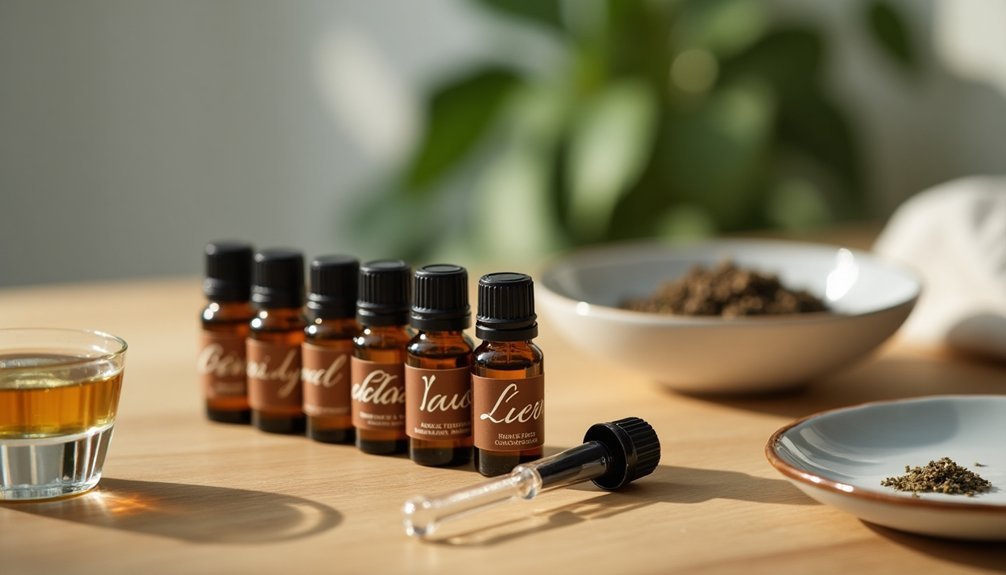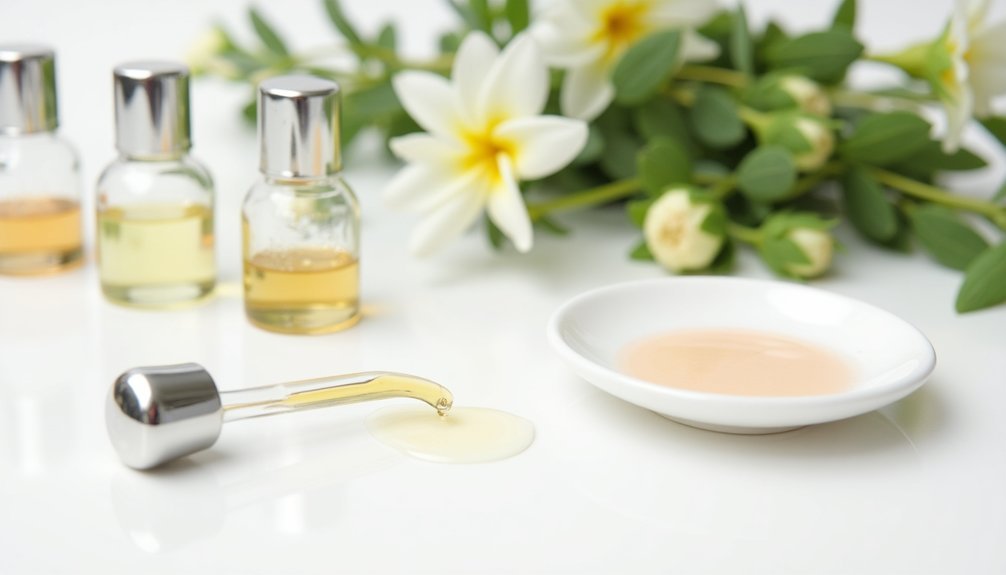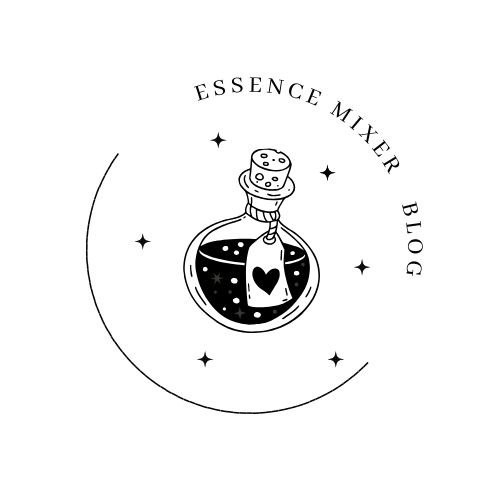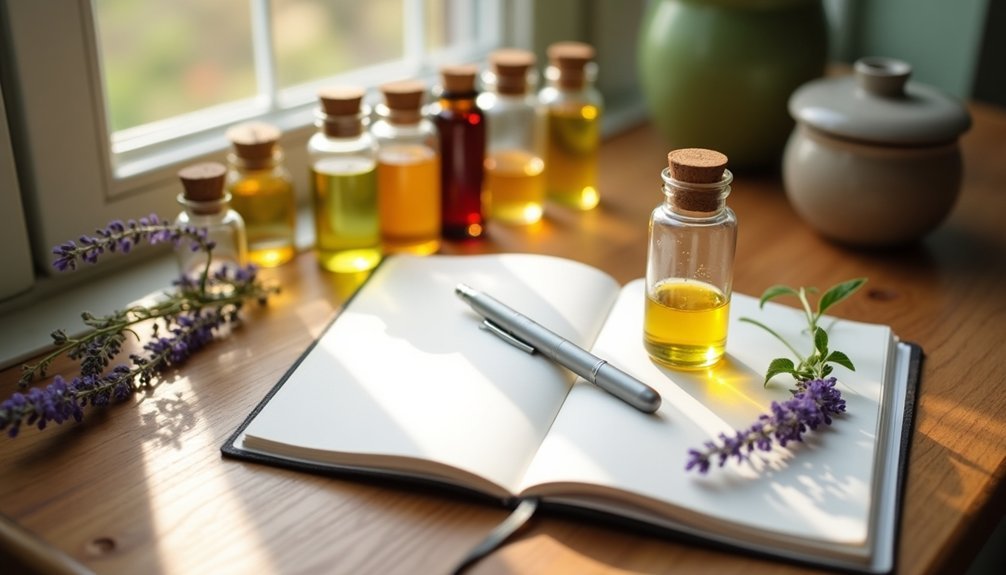To test fragrances properly, you'll need paper blotters and a clean olfactory palate. Start by spraying each scent from 6-12 inches above the blotter, waiting 30 seconds between sniffs. Test no more than three fragrances per day, using coffee beans to reset your nose between samples. For skin testing, apply two spritzes to your wrist and track how the scent develops over 15-30 minutes. This systematic approach will transform your fragrance journey.
Essential Tools for Scent Testing

Five essential tools form the foundation of proper scent testing: paper blotters, your skin, a perfume notebook, olfactory cleansers, and most importantly – time.
When you're testing scents, start with paper blotters to capture fragrance notes through quick sprays in the air.
Next, use your skin's pulse points, like your wrist or the back of your hand, to experience how the scent interacts with your body chemistry.
Keep a perfume notebook handy to document your impressions as you test each fragrance.
Between testing different scents, reset your nose using coffee beans or clean skin as olfactory cleansers.
Finally, give yourself plenty of time – at least 15-30 minutes – to observe how each fragrance evolves on your skin before making any judgments.
Understanding Fragrance Notes
When you test a new fragrance, you'll notice how the bright top notes quickly fade within the first half hour, making way for the more substantial heart notes.
The heart notes form the fragrance's core character and stay with you for several hours, revealing floral, fruity, or spicy elements.
Finally, the foundational base notes emerge to provide lasting depth through woods, resins, and musks that ground the entire scent experience.
Top Notes First Fade
The first scents you'll experience from any fragrance are its top notes – those bright, fleeting aromas that dance off your skin within minutes of application.
When testing fragrances, you'll notice these fresh scents typically last between 5 to 30 minutes before fading away.
Understanding this quick fadeaway is key to your fragrance journey. Top notes evaporate rapidly because of their light molecular structure, which is why you shouldn't base your entire fragrance decision on this initial burst of scent.
While these opening notes often feature citrus, herbs, or fruits, they're just the beginning of your fragrance's story.
Heart Notes Last Longer
Moving beyond the fleeting top notes, you'll discover heart notes that form the true essence of your fragrance.
These middle notes emerge as your initial scent fades, lasting longer and defining the core character of your perfume. You can expect heart notes to remain present for 3 to 5 hours, depending on your skin chemistry and the fragrance composition.
When you're conducting scent evaluation, pay special attention to these heart notes, as they'll bridge the gap between the volatile top notes and deeper base notes.
Common heart notes include romantic florals like rose and jasmine, along with fruity elements such as peach and berries.
Understanding how these notes develop over time will help you better appreciate the fragrance's evolution and make more informed choices about your preferred scents.
Base Notes Ground Scents
Base notes serve as your fragrance's anchor, providing a rich foundation that emerges after top and heart notes fade away.
You'll typically notice these deeper scents, like patchouli, vanilla, amber, musk, and sandalwood, developing on your skin after about 30 minutes of wear.
When you're testing fragrances, don't rush to judge the scent immediately. Base notes need time to interact with your body chemistry and reveal their true character.
These fundamental elements create the lasting impression that defines how others will remember your signature scent. Since base notes can persist for hours or even days, they're vital in determining whether a fragrance truly suits you.
Take time to experience how these grounding notes evolve throughout the day before making your final decision.
Proper Blotter Testing Techniques
When testing fragrances on blotters, you'll want to spray from about 6-8 inches above, creating a gentle mist that settles evenly on the paper strip.
To maximize your scent evaluation accuracy, wait at least 30 seconds between sniffing different test strips, giving your nose time to reset.
You can further enhance your olfactory perception by keeping coffee beans nearby as a palate cleanser between sampling different fragrances.
Spray Distance and Height
To properly test fragrances on blotters, maintaining the correct spray distance and height is essential for accurate scent evaluation.
You'll want to hold the fragrance bottle 6-12 inches away from your blotter to create an ideal scent cloud. Spray two to three quick spritzes above the blotter, allowing for even fragrance absorption without oversaturating the paper.
Move your blotter horizontally through the cloud to capture the scent's full complexity.
Once you've applied the fragrance, wait a few moments before you smell it. This pause lets the alcohol evaporate and reveals the true character of the scent.
When you're ready to test, hold the blotter about an inch or two from your nose – this distance helps you experience all the fragrance nuances without overwhelming your senses.
Rest Between Test Strips
Taking breaks between testing different fragrances is essential for maintaining your olfactory sensitivity. When you're exploring multiple scents, limit yourself to testing only three perfumes per day on your test strips. This prevents sensory fatigue and guarantees you'll get an accurate impression of each fragrance's unique character.
After spraying each test strip, wait at least 30 seconds before evaluating the notes. You'll want to close your eyes while inhaling to enhance your sensory perception.
Between different scents, use coffee beans as an olfactory palate cleanser to reset your nose. Don't forget to document your impressions in a perfume notebook, recording how the fragrance develops over time. This systematic approach will help you better understand and remember each scent's distinct qualities.
Skin Testing Methods

Proper skin testing stands as the most reliable method for evaluating how a fragrance will truly interact with your body chemistry.
To conduct effective skin testing methods, spray two downward spritzes on your wrist or the back of your hand. Let the scents settle for at least 30 seconds before taking your first sniff.
You'll want to wait 15-30 minutes to fully experience how the fragrance notes develop with your unique skin chemistry. During this time, don't wear any other scents that could interfere with your assessment.
As you test, document impressions of how the fragrance evolves, from its initial top notes through the heart notes and final dry down. This systematic approach helps you track your preferences and make better fragrance choices in the future.
Scent Development Over Time
Understanding how fragrances evolve is essential for making informed scent choices. When you first apply a fragrance, you'll smell the top notes, which last about 15-30 minutes.
Don't rush to judgment – the scent's true character emerges as it develops over time. The heart notes, which define the fragrance's main personality, appear next and can last several hours.
You'll notice the smell transforming as base notes gradually surface, providing depth that can linger for up to 24 hours. Your skin chemistry greatly affects this development, as factors like pH and diet influence how the scent interacts with your body.
For the best testing experience, wait 15-30 minutes after applying the fragrance before making your final assessment. This allows the notes to unfold naturally, revealing their full complexity.
Managing Olfactory Fatigue

When testing multiple fragrances, your nose can quickly become overwhelmed and lose its ability to distinguish between scents – a phenomenon known as olfactory fatigue.
To maintain accurate scent perception, you'll need to implement specific strategies to protect your sense of smell.
Keep these essential tips in mind to combat olfactory fatigue:
- Limit yourself to testing only three fragrances per day on blotters
- Use coffee beans between tests to cleanse your olfactory palate
- Don't wear any personal fragrance during testing sessions
Remember to space out your testing intervals by 15-30 minutes, allowing each scent to fully develop.
During these breaks, engage in other activities to help reset your nose's sensitivity.
This systematic approach guarantees you'll experience each fragrance's true character without compromising your ability to make accurate assessments.
Recording Your Fragrance Journey
Now that you've learned to manage olfactory fatigue, keeping detailed records of your fragrance experiences will transform your testing process into a valuable learning journey. Start a perfume notebook to document each new fragrance you encounter, tracking how perfume notes evolve on your skin.
| Recording Method | Purpose |
|---|---|
| Dedicated Notebook | Track daily impressions and scent progression |
| Digital Lists | Organize wants, likes, and dislikes |
| Notes App | Document purchase considerations |
Create organized lists to catalog your fragrance encounters, making it easier to identify patterns in your preferences. By reviewing your documented experiences, you'll discover which scent families consistently appeal to you. This systematic approach helps you make informed decisions when selecting your signature scent and builds your fragrance expertise over time.
Building Your Scent Vocabulary
A robust scent vocabulary serves as your foundation for appreciating and discussing fragrances effectively. When you're building your scent vocabulary, start by exploring different fragrance families like floral, woody, and gourmand.
You'll learn about perfumes more effectively by keeping a fragrance journal to document your experiences and read the notes you discover.
- Practice smelling various herbs, spices, and aromatic ingredients to train your nose in recognizing distinct notes.
- Use descriptive terms like fresh, spicy, sweet, or earthy to articulate your impressions.
- Familiarize yourself with common fragrance notes such as vanilla, jasmine, and sandalwood to better communicate your preferences.
The more you engage with fragrances and practice identifying their characteristics, the more naturally you'll develop your ability to describe and discuss scents with confidence.
Frequently Asked Questions
What Is the 30 50 20 Rule for Perfume?
You'll want to divide your perfume collection into 30% fresh scents, 50% floral or fruity fragrances, and 20% deeper scents like woody or oriental notes to maintain a well-balanced fragrance wardrobe.
How to Test a Fragrance Properly?
First, spray the fragrance on paper blotters and smell from a distance. Then apply two spritzes to your wrist, wait 30 seconds, and let it develop for 15-30 minutes. Don't test more than three fragrances daily.
How Do I Figure Out My Scent?
Start by sampling different scent families on your skin, not paper. Keep track of how you feel about each fragrance, and note which ones you're naturally drawn to throughout the day.
What Can I Spray Perfume on to Test It?
You'll get the best results by spraying perfume on your wrist or back of hand. While paper blotters work for initial testing, your skin's natural chemistry helps reveal how the fragrance will truly develop.
In Summary
You're now equipped with the fundamentals of scent testing. Don't forget to keep your testing kit organized, give each fragrance proper time to develop, and maintain detailed notes of your experiences. As you continue exploring different scents, you'll develop a sharper nose and broader fragrance vocabulary. Remember to take breaks between testing to avoid sensory overload. Start small, stay curious, and trust your nose's journey.





Leave a Reply